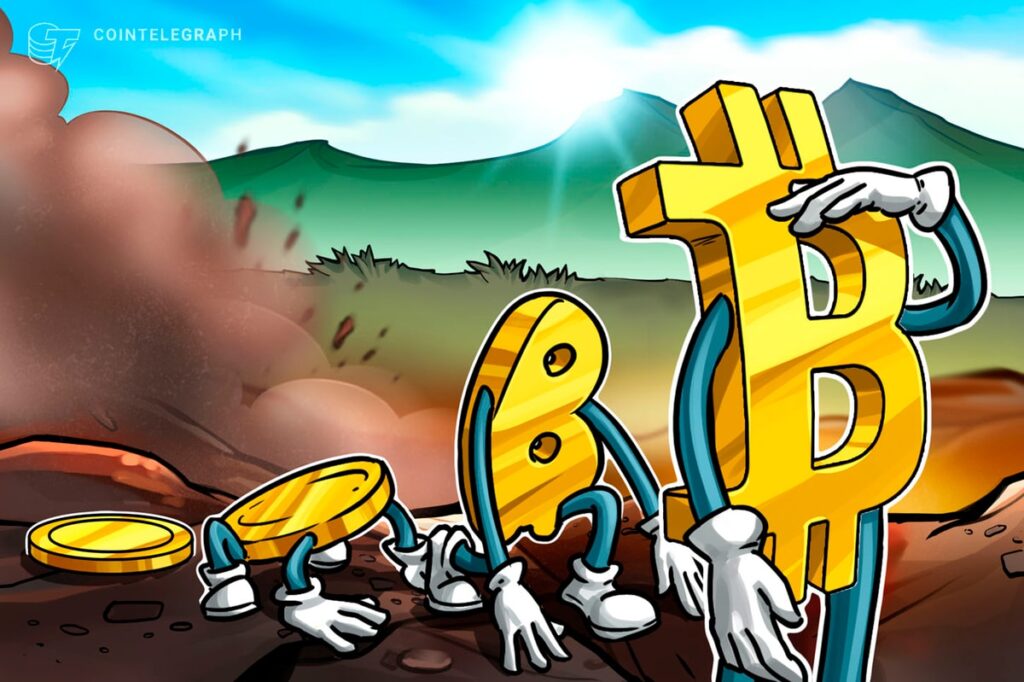After more than 15 years, Bitcoin has finally broken above $100,000 — a massive milestone for the world’s first decentralized digital asset whose value was once so low it was given away for free.
Today, it’s in the hands of some of the world’s most recognized financial institutions, and its value would rank it on par with some of the top ten countries by gross domestic product.
Here’s a look at how the price of Bitcoin (BTC) went from essentially nothing to where it is today.
The Bitcoin Faucet — BTC for nothing
Bitcoin was first launched on Jan. 3, 2009, with its pseudonymous creator, Satoshi Nakamoto, mining the first-ever block. Three days later, on Jan. 12, Nakamoto completed the blockchain’s first transaction, sending 10 BTC to software developer Hal Finney.
In those early days, Bitcoin was basically worthless, and the only way to get any was to mine it — which could be done with just about any computer at the time.
Early Bitcoin lead developer Gavin Andresen was one of those mining the crypto. In June 2010, he created “The Bitcoin Faucet,” a site that gave away 5 BTC to every visitor, which reset every day, and all they had to do was solve a CAPTCHA.
The Bitcoin Faucet as it appeared in July 2010. Source: Internet Archive
Andresen first loaded his site up with 1,100 BTC, but later reloads and donations from others meant the site gave away 19,700 BTC — $1.97 billion with Bitcoin at $100,000.
Two large Supreme pizzas? That’ll be $1 billion, please
That same year, Bitcoin was being traded essentially for fun by cypherpunks who determined its value on the Bitcoin Talk forum — but one transaction on May 22, 2010, by programmer Laszlo Hanyecz, would go down in history as the first commercial transaction with Bitcoin.
Hanyecz posted on Bitcoin Talk that he would give 10,000 BTC, worth roughly $40 at the time, to anyone who would give him two large pizzas.
A British user took him up on the deal and ordered two supreme pizzas from Papa John’s, worth about $25 each.
The supreme pizzas purchased by Hanyecz in 2010. Source: Internet Archive
Those 10,000 BTC are now worth $1 billion, and the date of Hanyecz’s order is known and celebrated by crypto fans as Bitcoin Pizza Day.
If Hanyecz had held onto his 10,000 BTC until today, he could have bought a 65% share in Papa John’s $1.54 billion business.
US dollar parity, Nakamoto vanishes
Bitcoin reached parity with the US dollar on Feb. 9, 2011, hitting $1 for the first time ever on Mt. Gox, an early, now defunct, crypto exchange.
A few months later, in April 2011, Nakamoto sent their last verified communication.
$100 to $1,000: Bitcoin’s massive 2013
Not much happened with Bitcoin in 2012 — it was mainly used on the online black market Silk Road and traded on Mt. Gox around this time. It was also the main subject of a January episode of the legal drama The Good Wife titled Bitcoin for Dummies, which was believed to be the first time it was mentioned on mainstream TV.
⚡️FLASHBACK: The first time #Bitcoin was mentioned in a TV show named The Good Wife.
This was 2012, Bitcoin was only at $3.👀 pic.twitter.com/tRUbxKjDUd
— Cointelegraph (@Cointelegraph) October 19, 2024
That all changed in 2013. Bitcoin entered the year at around $13, then hit $100 in April. It crept up throughout the year before jumping 450% in November to cross $1,000 and hitting a high of over $1,100 on Nov. 30, 2013.
Between April 2013 and January 2014, Bitcoin hit a low of $67 and a high of over $1,000. Source CoinGecko
A 2018 research paper later claimed that the massive price jump in late 2013 could have been the actions of a single person using bots and fraudulent transactions to fluff up the volume on Mt. Gox and make the market look bigger than it was.
Around this time, Bitcoin started to enter the wider public consciousness. Silk Road creator Ross Ulbricht was arrested on Oct. 1, 2013, and the FBI seized thousands of BTC.
Later that month, on Oct. 29, the world’s first Bitcoin ATM went live in a downtown Vancouver coffee shop.
China, which would later totally ban crypto in 2021, started its crypto crackdown in 2013, with the government prohibiting financial firms from trading in Bitcoin or providing services to crypto companies.
$1,000 to $10,000 — the 2017 ICO boom
Bitcoin kept its over $1,000 high for years, entering a bit of a lull period after 2013 as Mt. Gox — which handled about 70% of all Bitcoin transactions — stopped operating in early 2014, which was later revealed to be due to a massive hack which went unnoticed for years.
It wasn’t until January 2017 when Bitcoin again crossed over $1,000, spurred on by a new wave of interest in crypto due to a flurry of initial coin offerings (ICOs) on Ethereum.
The 2017 ICO bubble saw a huge Bitcoin surge and dump within a year, recovering over 2019. Source: CoinGecko
Bitcoin crossed $10,000 in late November 2017 and nearly touched $20,000 by December. After the ICO bubble burst, Bitcoin traded at a low of $3,200 a year later in December 2018.
In July 2017, a yellow notepad with “Buy Bitcoin” written on it was flashed behind then-Federal Reserve Chair Janet Yellen during a televised congressional hearing. The notepad was later sold for 16 Bitcoin in April 2024, worth over $1 million at the time.
In January 2018, the blockchain’s first scaling solution, the Lightning Network, went live, bringing faster transactions to Bitcoin.
BTC didn’t cross its nearly $20,000 high for years, but when it did — it did so in spectacular fashion.
$60,000 — the COVID boom
The year 2020 was marred by wider economic stagnation as businesses shut down and people were ordered to stay home in the early months of the COVID-19 pandemic, but Bitcoin nudged up, quadrupling from a low of $5,000 in March to nearly $20,000 by December.
But, bored from back-to-back lockdowns and flush with a few extra dollars from government stimulus checks — retail traders piled into crypto and so-called meme stocks in 2021.
Bitcoin ripped, going from below $20,000 on Dec. 1 to nearly $30,000 by New Year’s Day 2021. It hit $40,000 just days later on Jan. 9, then $50,000 by mid-February before crossing $60,000 in March.
With the market overheated, Bitcoin dropped by half to under $30,000 by late July but then surged again to hit a high of $67,617 by early November 2021 — a peak price it kept until 2024.
$70,000 — the ETFs
The years after Bitcoin’s 2021 peak were a bit of a dark period, with regulators worldwide cracking down on crypto in a big way over 2022 and 2023 after the collapse of the Terra blockchain. It hit a low of $15,700 just 12 months after its November 2021 high.
On Jan. 21, 2023, the first Ordinal inscription was inscribed on the blockchain, bringing non-fungible token (NFT)-like assets to Bitcoin, opening the door to fungible BRC-20 tokens a few months later in March.
By late 2023, Bitcoin had recovered to around $40,000 amid renewed interest as 11 big-name US financial firms filed for Bitcoin exchange-traded funds (ETFs), which the US Securities and Exchange Commission approved to start trading on Jan. 11.
It took a few months for Bitcoin’s price to catch up, but it did in mid-March when it broke over $70,000 and hit a peak of $73,000.
$90,000 and beyond — the Trump pump
Bitcoin fell into a range-bound trade of between $55,000 and $65,000 in the months after its March peak until Donald Trump won the US presidential election held on Nov. 5.
Trump ran a pro-crypto campaign promising legal clarity and an end to perceived regulatory hostility in the US, with his election win kicking off renewed optimism in the crypto markets.
Related: ‘There is a global race underway for Bitcoin’ — Anthony Pompliano
Bitcoin surged from around $68,000 on election day to pop over $90,000 about a week later on Nov. 13 before surging again to over $100,000 on Dec. 5.
Despite breaking six figures, some pundits speculate that Bitcoin still has more to give in, with some estimating Bitcoin could again double to hit $200,000 by the end of 2025, spurred on by Trump’s promise of creating a massive government stockpile of Bitcoin.
Some Bitcoin bulls are holding out hope that Bitcoin will hit $1 million in the next few years. If so, it only has a 900% gain to go — something this cryptocurrency has repeatedly done.
The world’s first cryptocurrency has gone from buying up pizzas to an asset America’s politicians think can solve a debt crisis, and Bitcoin is surely not going away anytime soon.
Magazine: AI may already use more power than Bitcoin — and it threatens Bitcoin mining


